technical data AUDI A5 CABRIOLET 2011 Manual Online
[x] Cancel search | Manufacturer: AUDI, Model Year: 2011, Model line: A5 CABRIOLET, Model: AUDI A5 CABRIOLET 2011Pages: 364, PDF Size: 86.48 MB
Page 165 of 364

______________________________________________________ P_a _ r_ k_ a_ s_s _i _ s _t __ _
Please note that low objects already signaled by a warning can disap
pear from the system's detection range and will not continue to be
signaled.
If the distance to an obstacle remains the same, the vo lume of the
distance warning is gradually reduced after about 4 seconds.
Approaching another obstacle will result in the distance warning
sounding at the normal volume again.
Malfunctions in the system
If a warning tone is aud ible for about five seconds when you turn on
the ignition , there is a malfunction in the system. Have the problem
corrected by your authorized Audi dealer.
Keep the sensors in the rear bumper clean and free from ice so that
the acoustic park assist system can function properly.
& WARNING
• Sensors have dead spaces in which objects cannot be detected.
Be especially alert for small children and animals, since they are
not always detected by the sensors.
• The Acoustic Parking System is not a substitute for the driver's
own caution and alertness. Ultimate respon sibility always
remains with the driver during parking and similar maneuvers.
Always watch where you are driving.
• You should always adjust the volume and frequency of the
chimes so that you can easily hear the acoustic distance warning
even if the radio is playing, the air-conditioner blower is on High
or there is a high level of outside noise .
- Check the settings whenever anyone else has driven the
vehicle before you.
0 Note
• Remember that low obstacles for which a warning has already
been issued may "dive" below the system 's sensing zone if the veh icle
is be ing backed up closer . In this case, the warning sound shutting off
Controls and equip
ment Safety first
does not ind
icate that you have cleared the obstacle . Instead, impact
is immin ent.
• Objects such as trai ler hitches, chains, narrow posts or fences
covered by a thin layer of paint may not always be detec ted by the
system . They can still damage your vehicle w ithout warning .
lI] Tips
Keep the sensors in the rear bumper clean and free of snow and ice so
that the aco ustic parking assist system can function properly.•
Applies to ve hicle s: wit h pa rkin g system (re ar)
Adjusting the chimes
The volume and the pitch (frequency) of the chimes can
be adjusted in the radio or in the /11/111*.
Rear volume adjustment
-Select: [CAR]> Parking system .
- Select Rear volume if you want to change the volume of
the rear signal generator.
Rear frequency adjustment
- Select: [CAR]> Parking system.
- Select Rear frequency when you want to change the
frequency of the rear audible signal generator.
When adjusting the volume and frequency, the new sett ing will
sound for approx. 2 seconds from each audib le signal generator. The
vol ume and frequency settings are automatically stored and assigned
to the master key with remote control. .,_
Vehicle care Technical data
Page 167 of 364

______________________________________________________ P_a _ r_ k_ a_ s _ s_is _ t _ __.fflll
A ppli es to veh icl es: wi th park ing s yst em (r ear ) and re ar-view camera
General Information
®
Sensors in the bumper
Fig . 169 Covered area
(!) and uncovered area
@ of the rear-view
camera
Fig. 170 Trunk lid:
location of the rear
view camera
Sensors are located in the front and rear bumpers. If these detect an
obstacle, audible and visual signals warn you. The range at which the
sensors begin to measure is approximately:
To the side
Center rear
2 ft (0.60 m)
5.2 ft (1.60 m)
The closer you get to the obstacle, the shorter the interval between
the audible signals. A continuous tone sounds when the obstacle is
Con tro ls a nd e quip ·
m en t Vehicle
OP-eration
less than approximately 1 foot (0.30 meters) away . Do not continue
driving farther.
If the distance to an obstacle stays the same, the volume of the
distance signal chime is gradually reduced after about
4 seconds
(does not affect the continuous signal tone). Approaching another
obstacle will cause the distance signal to sound again at the normal
volume.
Rearview camera coverage area
The MMI display shows the area covered by the rearview
camera ::> fig.
169 (D. Objects that are not in the area covered@ are
not shown on the MMI display.
We recommend that you practice parking with the rear-view camera
in a traffic-free location or parking lot to become familiar with the
system, the orientation lines, and their function. When doing this,
there should be good light and weather conditions.
In the MMI display, objects or vehicles appear closer or further away
if:
• you are driving in reverse gear from a level surface onto an incline,
or a downward slope,
• you are driving in reverse gear toward protruding objects ,
• the vehicle is carrying too much load in the rear.
The accuracy of the orientation lines and blue surfaces diminishes if:
• the rear-view camera does not provide a reliable image, for
example, in poor visibility conditions or if the lens is dirty,
• the image on the screen is not visible due to sun glare and reflec
tion.
Caring for the rear-view camera lens
The rear-view camera is located above the rear license plate bracket.
For the parking assist to operate, the lens=> fig . 170 must be kept
clean:
• Dampen the lens with a household alcohol-based glass cleaner,
and clean the lens with a dry cloth=>
0. .,
Vehicle care Do-it-yourselt service iTechnical data
Page 169 of 364

___________________________________________________ P_ a_ r_k _ a _ s_s _ i_s _t _ __.fflll
If the warning message appears in the display but not the rear-view
camera picture, read and confi rm the warn ing message . The aco ustic
distance signal is always act ive.
If you press a function button on the MMI control console, the rear
view camera picture disappears. The rear-view camera picture reap
pears the next time you park .
Further information on the wa rning message and the MMI contro l
console can be found in the MMI instruct io n booklet.
(I] Tips
• The rear-view camera picture is ava ilable as soon as the MMI
Display or the MMI is .switched on, or the start-up phase is completed.
• Keep the sensors in the rear bumper and the rear-view camera lens
clean and free of snow and ice, so that the parking system can work
properly . Please follow the additional notes on=>
page 170. •
App lies to veh icles : w ith parking system (r ear) and rear-view camera
Reverse Parking
Parking mode 1 can be used when parking in a garage or
parking space.
Con tro ls a nd e quip
m en t
Fig. 17 1 MMI D ispla y:
Aim ing at a par king
sp ot
Vehicle OP-eration
Fig.172 MMI D ispl ay:
A lig ning the vehicl e
-Switch th e MMI on and select the reverse gea r.
- Turn the steering wheel until the orange orientation lines
(D appear in the parking spot=> fig. 171. Use the mark
ings @to help you es timate the distance from an
obstacle. Each marking co rres ponds to 3 ft (1 m). The
blue area repr esen ts an ext ension of the vehicle 's outline
by approximately 16 ft (S m) to the rear .
- While driving in reverse gear, adjust the steering wheel
angle to fit the parking space wi th the aid of the orange
orienta tion lines=>
0. ® marks th e re ar bumper . You
should sto p driving in reverse as soon as and no later than
when the red orientation line © abuts an object=> &!
& WARNING
• The re ar- vie w came ra doe s not sh ow th e entire are a behind the
veh icl e=>
pag e 165, fig. 169. Watch out espe ciall y for small chil
dr en and anim als. Th e rear-view cam era cannot alwa ys dete ct
th em, posing ri sk of an a ccident!
• Plea se note that objec ts not tou ching th e ground can appear to
be furthe r awa y than the y reall y are ( for e xample , th e bump er of
a p arked vehi cle, a trailer hitch , or the rear of a truck ). In thi s ca se, .,_
Vehicle care Do-it-yourselt service iTechnical data
Page 171 of 364
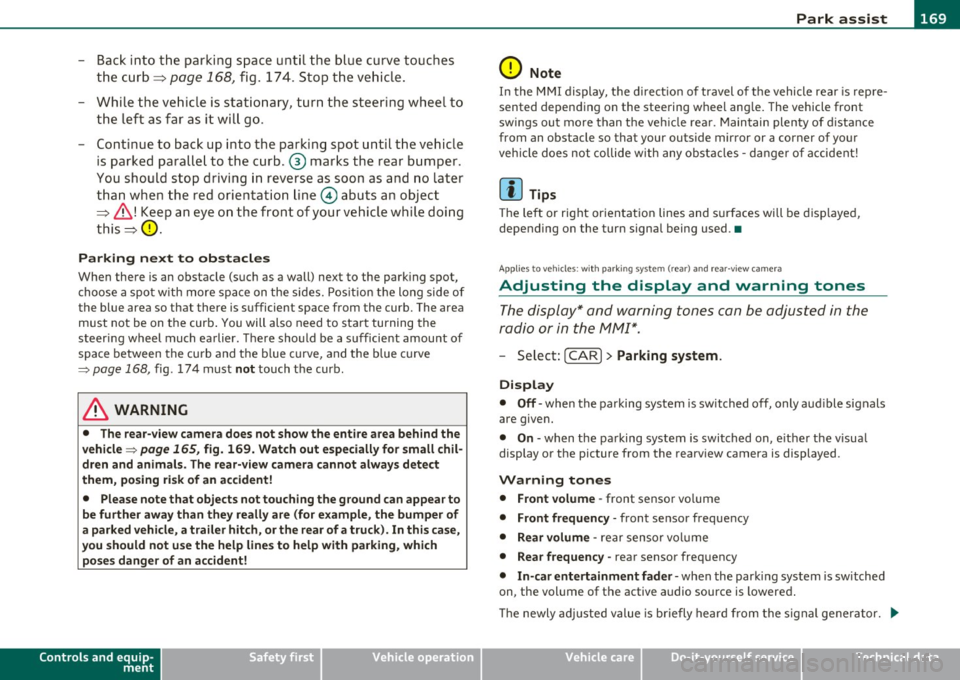
_________________________________________________ P_ a_ r_k _a_ s_s _is _ t __ _
- Bac k into the parking space un til the bl ue curve touches
the curb =:>
page 168, fig. 17 4. Stop the vehicle .
- While th e ve hicle is statio nary, turn the steering wheel to
the left as far as i t wil l go .
- Continue to back up into the parking spot until the vehicle
is parked paralle l to the curb. @ mar ks the rear bumper .
You should stop driving in reverse as soon as and no late r
than when the red orie ntatio n line
0 abuts an object
:::::, & ! Keep an eye on the f ront of you r ve hi cle while doi ng
this =:>
0.
Parking next to obstacles
When there is an obstacle (such as a wall) next to the park ing spot,
choose a spo t w ith more space on the s ides. Pos ition the long side of
the blue area so that there is sufficient space from the curb. The area
must not be on the curb . You will also need to star t turning the
steeri ng wheel much earlier. There sho uld be a suff icie nt amount of
space between the cu rb and t he b lue c urve, and the blue c urve
=> page 168, fig . 1 74 must not touch the curb .
& WARNING
• The rea r-view camera does not show the entire a rea behind the
vehicle =>
page 165, fig. 169. Watch out e speciall y for small chil·
dren and animals . The rear-view camer a cannot always dete ct
them , posing ri sk of an accident!
• Please note th at objects not touching the ground can appear to
be further away than they really are (for example, the bumper of
a park ed vehicle, a trailer hit ch, or the r ear of a truck). In this ca se,
you should not u se the help line s to help with pa rking , which
po se s danger of an accident!
Controls and equip
ment Safety first
0 Note
I n the MMI display, the d irect io n of travel of t he vehicle rear is rep re
sented depending on the steering wheel ang le. The vehicle front
sw ings ou t mo re than t he veh icle rea r. M ain tain plenty of d ista nce
from an obstacle so that your outside mirror or a corner of your
vehicle does not collide w ith any obstacles -dange r of a ccident!
[ i ] Tips
Th e left or r ight or ien tat ion lines and s urf aces will be d isp laye d,
depending on the turn signal being used .•
A pp lies to veh icles : w ith par king system (rea r) and rea r-vi ew camera
Adjusting the display and warning tones
The display* and warning tones can be adjusted in the
radio or in the /11/111* .
- Select: [C A R]> Parking sy stem.
Display
• Off -when the parking system is switched off, only aud ible signals
are given.
• On -when the pa rking system is switched on, e ithe r the v isua l
display or the picture from the rearv iew camera is displayed .
Warning tones
• Front volume -front sensor vo lume
• Front frequ ency -front sensor frequency
• Rear volume -rear sensor vol ume
• Rear frequency -rear sensor freq uency
• In-car entertainm ent f ader · when the parking system is switched
on, the volume of the active a udio source is lowered .
Th e newly ad justed v alue is briefly hear d from the s ignal ge nerator.
~
Vehicle care Technical data
Page 173 of 364
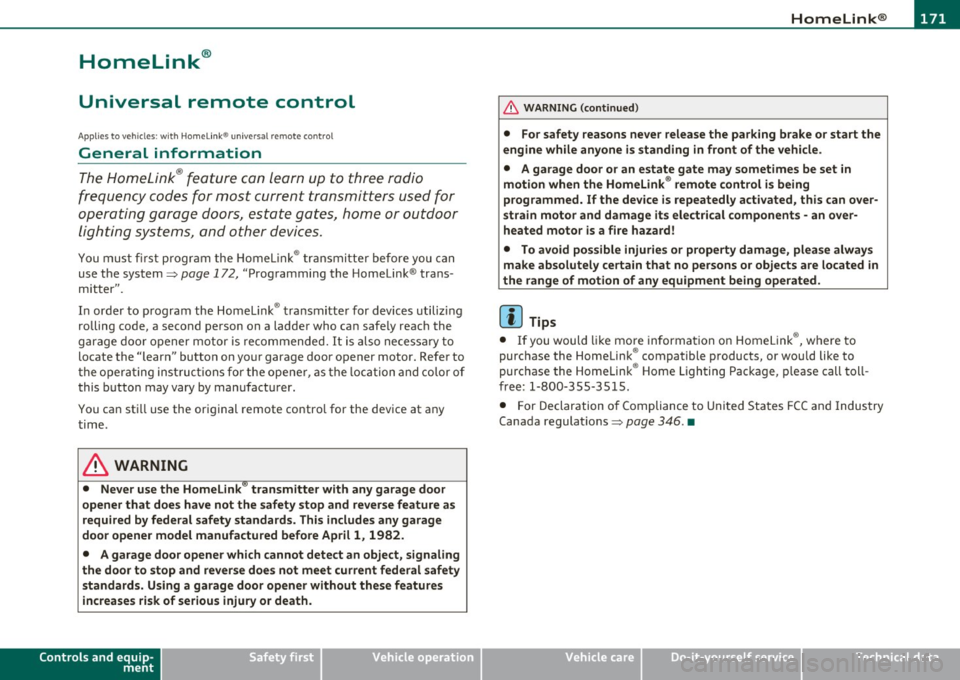
HomeLink® -
----------------
Homelink®
Universal remote control
Applies to veh icles: w ith Hom eli nk ® universal remote control
General information
The Homelink ® feature can learn up to three radio
frequency codes for most current transmitters used for
operating garage doors, estate gates, home or outdoor
lighting systems, and other devices.
You must first program the Homelink ® transm itter before you can
use the system=>
page 172, "Programming the Home link® trans
mitter".
I n order to program the Homelink ® transmitter for devices utilizing
rolling code, a second person on a ladder who can safe ly reach the
garage door opener motor is recommended. It is also necessary to
locate the "learn" button on your garage door opener motor. Refer to
the operating instructions for the opener, as the location and color of
this button may vary by manufacturer.
You can still use the original remote control for the device at any
time.
& WARNING
• Never use the Homelink'"' transmitter with any garage door
opener that does have not the safety stop and reverse feature as
required by federal safety standards. This includes any garage
door opener model manufactured before Aprill, 1982.
• A garage door opener which cannot detect an object, signaling
the door to stop and reverse does not meet current federal safety
standards. Using a garage door opener without these features
increases risk of serious injury or death.
Controls and equip
ment Safety first
& WARNING
(continued)
• For safety reasons never release the parking brake or start the
engine while anyone is standing in front of the vehicle.
• A garage door or an estate gate may sometimes be set in
motion when the Homelink ® remote control is being
programmed. If the device is repeatedly activated, this can over
strain motor and damage its electrical components -an over
heated motor is a fire hazard!
• To avoid possible injuries or property damage, please always
make absolutely certain that no persons or objects are located in
the range of motion of any equipment being operated.
rn Tips
• If you would like more information on Homelink ®, where to
purchase the Homelink ® compatible products, or would like to
purchase the Homelink ® Home Lighting Package, please call toll
free: 1-800-355-3515.
• For Declaration of Compliance to United States FCC and Industry
Canada regulations=>
page 346 . •
Vehicle care Technical data
Page 175 of 364

HomeLink® -_______________ __.
10. Press and hold the trained Homelink ® button and
observe the indicator light©~
page 172, fig. 175 .
- If the indicator light is solid/continuous, programming is
complete and your device should activate when you press
and release the trained Homelink ® button.
- If the indicator light blinks rapidly for 2 seconds and is
then a solid/continuous light, proceed with phase 3 to program a rolling code device .
Phase 3: rollin g code progr amm ing
- A second person on a ladder who can safely reach the
garage door opener motor is recommended.
11. Locate the "learn" button on the garage door opener
motor (refer to the operating instructions for the opener,
as the location of this button may vary by manufacturer) .
12. Press and release the learn button on the garage door opener motor.
- Note: once the button is pressed, there are 30 sec ond s in
which to initiate the next step.
13. On the Homelink ® keypad inside the vehicle, firmly press
and hold the Homelink ® button previously programmed
in phases 1 and 2 for two seconds and release. Repeat this
sequence
twice .
-Some vehicles may require the press/hold/release
sequence up to three times to complete the training
process.
-HomeLink ® should now activate your rolling code
equipped device.
Con tro ls a nd e quip
m en t Vehicle
OP-eration
If the 5 minute time limit is exceeded, the em erge ncy fla shers w ill
fla sh on e t ime
to indicate that the process has been terminated. In
this case, repeat steps 4 through 9 .
If the emergency flashers do not flash
three times (after about 15-
60 seconds), programming was not successful. In this case, repeat
steps 4 through 9.
Remote control un its for garage door openers in Canada are set to
stop transmitt ing radio frequency signals after two seconds. This
time may not be sufficient for the Home link ® system to learn the
rad io frequency signal. Perform all other steps as described above .•
Applies to veh icles: with Homelin k® universal re mote cont rol
Operating the Homelink ® transmitter
The HomeLink ® transmitter works in the some manner as
the original hand held remote control that come with the
system.
Fig. 177 Overhead
conso le: Homeli nk®
k ey pad
- Press the appropriate programmed button G),@ or @
to activate the desired remote control function
~ & in
"General information" on
page 171. •
Vehicle care Do-it-yourselt service iTechnical data
Page 177 of 364

HomeLink® -
----------------
Controls and equip
ment Safety first
Vehicle care Technical data
Page 179 of 364
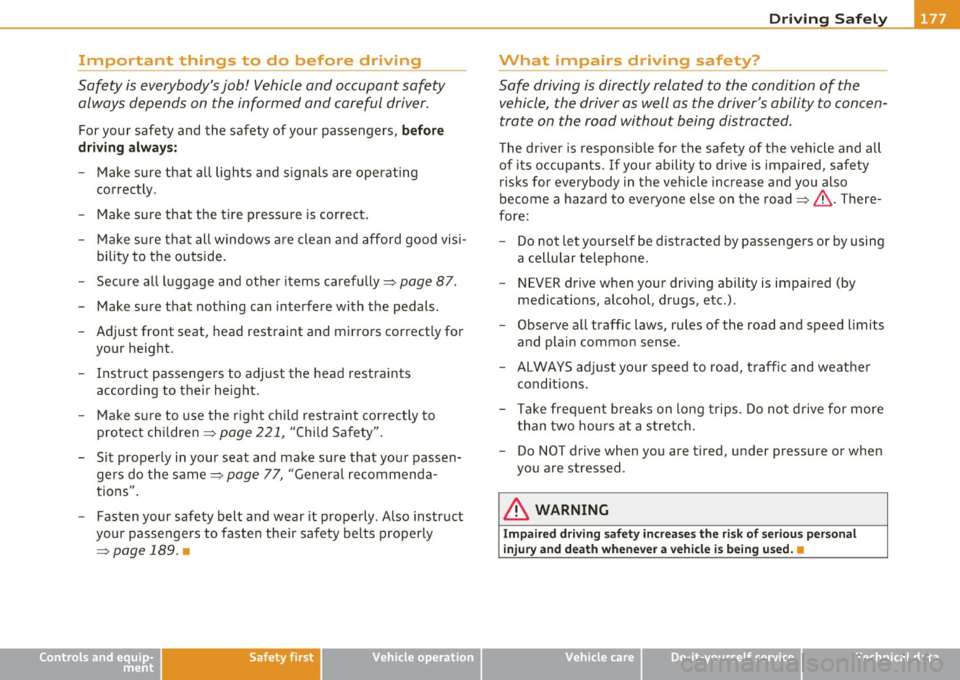
Driving Safely ---------------------"~'----
Important things to do before driving
Safety is everybody's job! Vehicle and occupant safety
always depends on the informed and careful driver.
For your safety and the safety of your passengers, before
driving always:
- Make sure that all lights and signals are operating
correctly.
- Make sure that the tire pressure is correct.
- Make sure that all windows are clean and afford good visi-
bility to the outside.
- Secure all luggage and other items carefully::::>
page 87.
-Make sure that nothing can interfere with the pedals.
- Adjust front seat, head restraint and mirrors correctly for your height .
- Instruct passengers to adjust the head restraints according to their height.
- Make sure to use the right child restraint correctly to
protect children ::::,
page 221, "Child Safety".
- Sit properly in your seat and make sure that your passen gers do the same::::,
page 77, "General recommenda
tions".
- Fasten your safety belt and wear it properly. Also instruct
your passengers to fasten their safety belts properly
=:> page 189. •
Controls and equip
ment Safety first Vehicle operation
What impairs driving safety?
Safe driving is directly related to the condition of the
vehicle, the driver as well as the driver's ability to concen
trate on the road without being distracted .
The driver is responsible for the safety of the vehicle and all
of its occupants. If your ability to drive is impaired, safety
risks for everybody in the vehicle increase and you also
become a hazard to everyone else on the road::::,,& . There
fore:
Do not let yourself be distracted by passengers or by using
a cellular telephone.
NEVER drive when your driving ability is impaired (by
medications, alcohol, drugs, etc.).
- Observe all traffic laws, rules of the road and speed limits
and plain common sense .
- ALWAYS adjust your speed to road, traffic and weather
conditions.
- Take frequent breaks on long trips. Do not drive for more than two hours at a stretch.
- Do NOT drive when you are tired, under pressure or when
you are stressed .
& WARNING
Impaired driving safety increases the risk of serious personal
injury and death whenever a vehicle is being used.•
Vehicle care Do-it-yourself service Technical data
Page 181 of 364
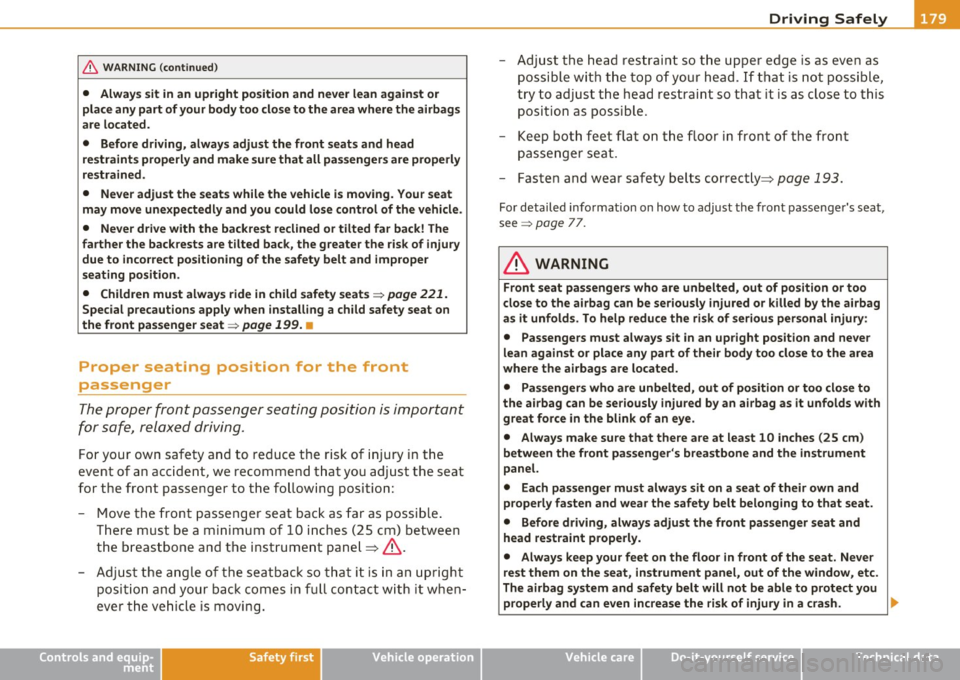
______________________________________________ D_ ri_v _ i_n _,,g ,c.._ S_a_ f_ e_ l..:: y __ _
& WARNING (continued)
• Always sit in an upright position and never lean against or
place any part of your body too close to the area where the airbags
are located.
• Before driving, always adjust the front seats and head
restraints properly and make sure that all passengers are properly
restrained.
• Never adjust the seats while the vehicle is moving. Your seat
may move unexpectedly and you could lose control of the vehicle.
• Never drive with the backrest reclined or tilted far back! The
farther the backrests are tilted back, the greater the risk of injury
due to incorrect positioning of the safety belt and improper
seating position. • Children must always ride in child safety seats~
page 221.
Special precautions apply when installing a child safety seat on
the front passenger seat~
page 199. •
Proper seating position for the front
passenger
The proper front passenger seating position is important
for safe, relaxed driving .
For your own safety and to reduce the risk of injury in the
event of an accident, we recommend that you adjust the seat
for the front passenger to the following position:
- Move the front passenger seat back as far as possible.
There must be a minimum of 10 inches (25 cm) between
the breastbone and the instrument panel=>&.
- Adjust the angle of the seatback so that it is in an upright
position and your back comes in full contact with it when
ever the vehicle is moving.
Controls and equip
ment Safety first Vehicle operation
-
Adjust the head restraint so the upper edge is as even as
possible with the top of your head. If that is not possible,
try to adjust the head restraint so that it is as close to this
position as possible.
- Keep both feet flat on the floor in front of the front
passenger seat .
- Fasten and wear safety belts correctly ::::>
page 193.
For detailed information on how to adjust the front passenger's seat,
see~ page 77.
& WARNING
Front seat passengers who are unbelted, out of position or too
close to the airbag can be seriously injured or killed by the airbag
as it unfolds. To help reduce the risk of serious personal injury:
• Passengers must always sit in an upright position and never
lean against or place any part of their body too close to the area
where the airbags are located.
• Passengers who are unbelted, out of position or too close to
the airbag can be seriously injured by an airbag as it unfolds with
great force in the blink of an eye.
• Always make sure that there are at least 10 inches (25 cm)
between the front passenger's breastbone and the instrument
panel.
• Each passenger must always sit on a seat of their own and
properly fasten and wear the safety belt belonging to that seat.
• Before driving, always adjust the front passenger seat and
head restraint properly.
• Always keep your feet on the floor in front of the seat. Never
rest them on the seat, instrument panel, out of the window, etc.
The airbag system and safety belt will not be able to protect you properly and can even increase the risk of injury in a crash.
II>
Vehicle care Do-it-yourself service Technical data
Page 183 of 364
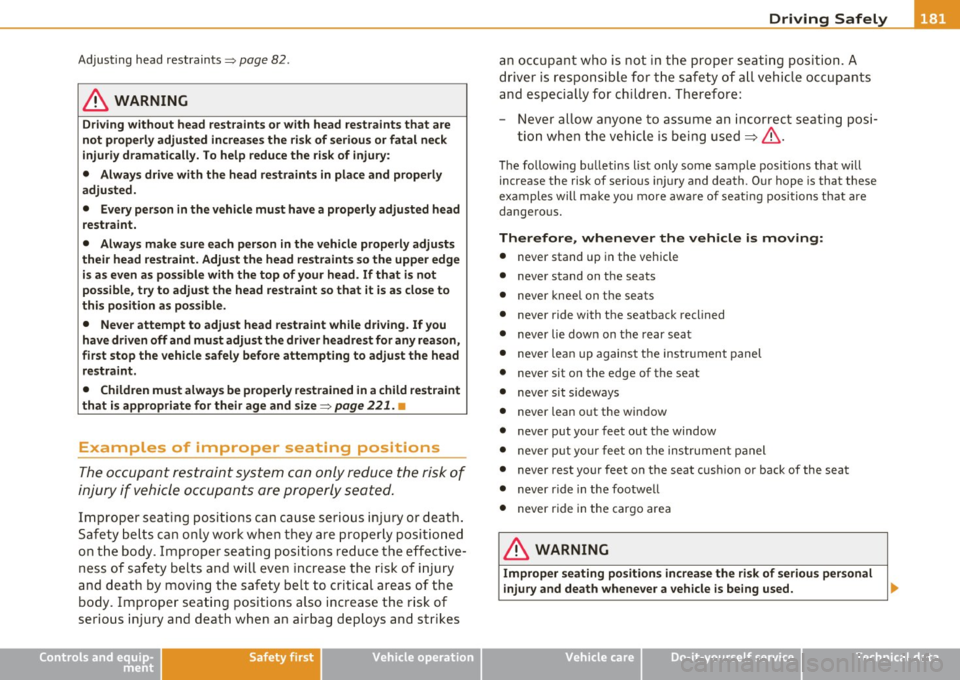
________________________________________________ D_ r_ i_ v _i_n ""'g "-- S_a_ f_ e_ l _,,y'-- __
Adjusting head restraints=> page 82.
& WARNING
Driving without head rest raints or with head restraint s that are
not properl y adju sted increa se s the risk of seriou s or fatal neck
injuriy dram atically. To help reduce the risk of injury :
• Always drive w ith the h ead restraints in place and properly
adjusted.
• Every person in the vehicle must have a prope rly adju sted head
restraint.
• Always make sure each person in the vehicle properly ad justs
their head restraint. Adju st the head restraints so the upper edge
i s as even a s pos sible with th e top of your head . If that i s not
possible, try to adjust the head re straint so that it is as close to
this position as po ssible.
• Never attempt to adjust head restraint while driving. If you
have driven off and must adjust the driver headrest for any reason ,
first stop the vehicle safely before attempting to adju st the head
restraint.
• Children must alwa ys be properly restrained in a child re straint
that is appropriate for their age and size
=> page 221 . •
Examples of improper seating positions
The occupant res traint sy stem can o nly redu ce the risk of
injury i f veh icle occup ants are properly sea ted .
Im proper seati ng positio ns can caus e ser ious inju ry o r death .
Safety belts can on ly work w hen t hey are pro perly posi tio ned
on t he body. Impro per sea tin g posit io ns re duce the effect ive
ness of safety belts and w ill even increase the risk of i njury
and deat h by moving the s afety belt to crit ic a l areas of the
body. Imp roper seati ng positions also increase the r is k of
serious injury and death when an airbag deploys and str ikes
Controls and equip
ment Safety first Vehicle operation
an occ
upan t who is not in th e proper s eati ng pos ition . A
d river is respons ib le f or t he safe ty o f all vehic le occu pants
a nd especial ly for children . Therefore:
- Never allow anyone to a ssum e an in correc t sea ting pos i-
t ion whe n the v ehic le is bei ng us ed::::;, &.
The follow ing b ulletins list only some sample positions that will
increase the risk of serious in ju ry and death. O ur hope is that these
examples will ma ke you mo re awa re of seat ing posi tions t hat are
dangero us.
Therefore, whenever the vehicle is moving :
• never stand up in the vehicle
• never stand on the seats
• never knee l on t he se ats
• never ride with the seatback reclined
• never lie down on the rear seat
• never le an up agains t th e ins tru ment panel
• never sit on the edge of the seat
• neve r sit s ideways
• never lean o ut the win dow
• never put your feet out the window
• never p ut yo ur feet on the ins trumen t panel
• never rest your feet on the seat c ush ion or back of the seat
• never ride in the footwell
• never ride in the cargo area
& WARNING
Improper seating position s in crease the ri sk of seriou s personal
injury and death whenever a vehicle is being used. _,.
Vehicle care Do-it-yourself service Technical data